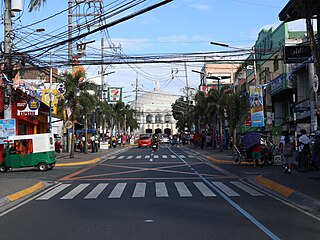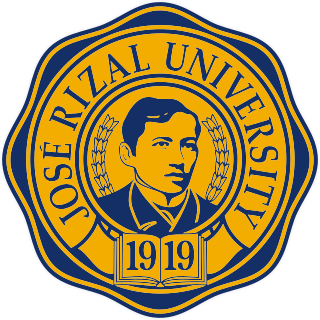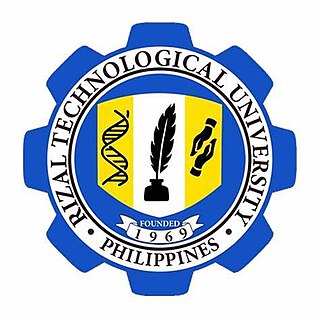
Metropolitan Manila, commonly shortened to Metro Manila and formally the National Capital Region, is the capital region and largest metropolitan area of the Philippines. Located on the eastern shore of Manila Bay, the region lies between the Central Luzon and Calabarzon regions. Encompassing an area of 636.00 km2 (245.56 sq mi) and with a population of 13,484,462 as of 2020, it consists of sixteen highly urbanized cities: Manila—the capital city—Caloocan, Las Piñas, Makati, Malabon, Mandaluyong, Marikina, Muntinlupa, Navotas, Parañaque, Pasay, Pasig, Quezon City, San Juan, Taguig, and Valenzuela, along with one independent municipality, Pateros. As the second most populous and the most densely populated region in the Philippines, it ranks as the 9th most populous metropolitan area in Asia and the 6th most populous urban area in the world.

Mandaluyong, officially the City of Mandaluyong, is a highly urbanized city in the National Capital Region of the Philippines. According to the 2020 census, it has a population of 425,758 people.

Antipolo, officially the City of Antipolo, is a component city and capital of the province of Rizal, Philippines. According to the 2020 census, it has a population of 887,399 people. It is the most populous city in Rizal Province and in Calabarzon region, and the seventh most-populous city in the Philippines. It is also the most populated city under the component city status.

Jose Paciano Laurel y García was a Filipino politician, lawyer, and judge, who served as the President of the Japanese-occupied Second Philippine Republic, a puppet state during World War II, from 1943 to 1945. Since the administration of President Diosdado Macapagal (1961–1965), Laurel has been officially recognized by later administrations as a former president of the Philippines.

Pagsanjan, officially the Municipality of Pagsanjan, is a municipality in the province of Laguna, Philippines. According to the 2020 census, it has a population of 44,327 people.

José Rizal University, also referred to by its acronym JRU, is a private non-sectarian, non-stock coeducational basic and higher education institution located in Mandaluyong, Metro Manila, Philippines. It was founded in 1919 by Don Vicente Fabella, the Philippines' first certified accountant. José Rizal University is one of the schools situated in the east side of Mandaluyong, the others being the Plaridel Campus of Arellano University and Don Bosco Technical College.

Doroteo Jose station is an elevated Light Rail Transit (LRT) station located on the LRT Line 1 (LRT-1) system in Santa Cruz, Manila. The station is situated on Rizal Avenue and slightly past Doroteo Jose Street. Both the station and the street are named after Doroteo Jose, a Filipino who was arrested by Spanish authorities in 1898 for leading a movement against a corrupt archbishop.

The Department of Health is the executive department of the government of the Philippines responsible for ensuring access to basic public health services by all Filipinos through the provision of quality health care, the regulation of all health services and products. It is the government's over-all technical authority on health. It has its headquarters at the San Lazaro Compound, along Rizal Avenue in Manila.
Education in the Philippines is compulsory at the basic education level, composed of kindergarten, elementary school, junior high school, and senior high school. The educational system is managed by three government agencies by level of education: the Department of Education (DepEd) for basic education; the Commission on Higher Education (CHED) for higher education; and the Technical Education and Skills Development Authority (TESDA) for technical and vocational education. Public education is funded by the national government.

The Philippine Normal University is a public coeducational teacher education and research university in the Philippines. It was established in 1901 through Act No. 74 of the Philippine Commission "for the education of natives of the Islands in the science of teaching". It has campuses in Manila, North Luzon, South Luzon, Visayas, and Mindanao. Pursuant to Republic Act No. 9647, it is the country's National Center for Teacher Education.

Rizal Technological University (RTU) is a state university based in the National Capital Region of the Philippines, with its main campus in Mandaluyong City and a branch in Pasig City. It was established on July 11, 1969, as the College of Rizal, before it became autonomous in 1975. The state university is also the first educational institution in the country to use cooperative education as a curriculum plan which is recognized by various industries, businesses and agencies all over the country. The university has various different academic fields, and focuses primarily on architecture, engineering, and technology programs.

The Philippine College of Health Sciences, Inc. (PCHS) is a private school located at 1813 Recto Avenue in Manila, Philippines. It was founded in 1993 by Dr. George Cordero.

Dr. Jose Fabella Memorial Hospital, the National Maternity Hospital, is a maternal and newborn tertiary hospital located in Santa Cruz, Manila in the Philippines. It also houses the Jose Fabella Memorial Hospital School of Midwifery, an institute recognized by the Professional Regulation Commission in the Midwife Licensure Examinations for its performance. In 2015, the World Health Organization recognized the hospital "as a role model of the World Health Organization-Western Pacific Region Office for its essential newborn care programs, which have been proven to reduce infant morbidity and mortality".

Neptali Alvaro Gonzales, better known as Neptali Gonzales, Sr., was a Filipino politician who served as the President of the Philippine Senate from 1992 to 1993, 1995 to 1996, and 1998.
Mandaluyong High School is a high school located in Mandaluyong, Metro Manila, Republic of the Philippines. Founded in 1977 through the initiative of the late Mayor Renato I. Lopez, Mandaluyong High School is the oldest public secondary school of Mandaluyong. Due to its scarcity of classrooms during its pioneering years, some classes had to be held in three different elementary schools. Evolving into a comprehensive four-year public high school with the construction of additional buildings and various facilities, the school now educates around 3,800 students in six buildings. With 55 classrooms, it has the largest building of all the city's schools.

Geronima Josefa Tomelden Pecson was an educator, suffragette, and social worker who became the first woman senator of the Philippines in 1947 and the first woman member of the Executive Board of the United Nations Educational, Scientific and Cultural Organization (UNESCO) in 1950.

José Fernández Fabella was a Filipino physician and a public health advocate described in a biography as the "father of public health and social welfare in the Philippines."

In the Philippines, disability is one of the social issues affecting a portion of the Philippines' population. To ensure the equality and rights of disabled persons, there are Philippine laws and policies that were passed regarding persons with disabilities (PWDs). There are also numerous non-government associations that seeks to encourage and help improve the wellbeing of people with disabilities.























